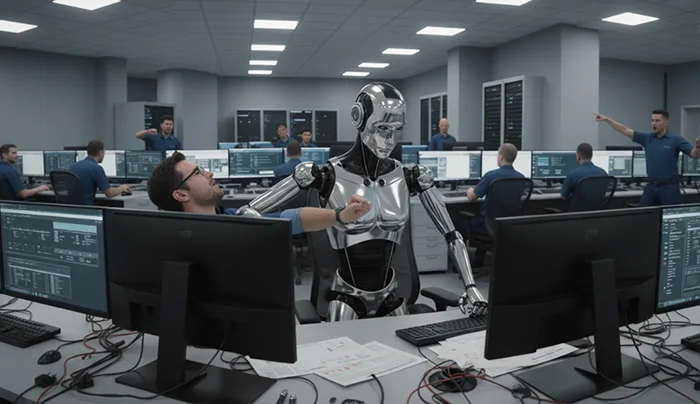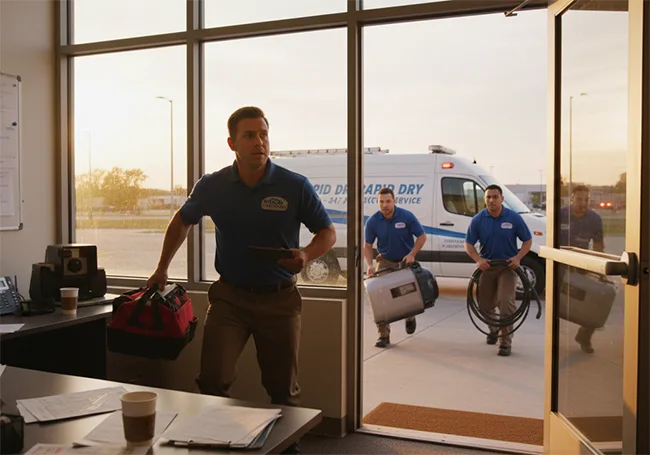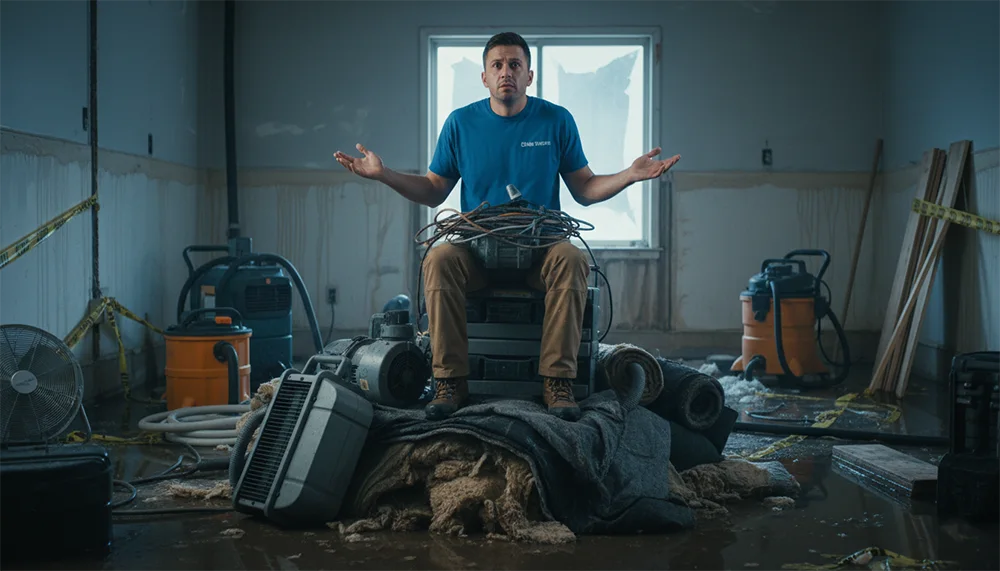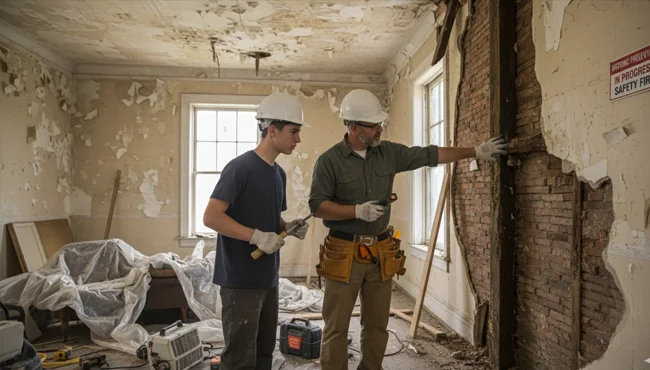The Unspoken Paradox of AI in a Crisis
Let’s be real. Technology moves fast, and AI phone assistance has gotten dramatically better over the last two or three years. The demos look slick, the voices are natural, and the promise of a 24/7 “employee” for just a few hundred bucks a month sounds like a dream for any water, fire, or mold damage restoration business owner.
But here’s the harsh truth that the developers aren’t talking about: modern AI is still fundamentally inadequate for the single most important moment in your business, the emergency first contact.
We’re not talking about general customer service for a retail store here. We’re talking about a homeowner or property manager calling you at 2 AM with a flooded basement or a house full of smoke damage. They are stressed, emotional, and facing a financial and physical crisis. The way that first call goes determines whether you win a $10,000 job or lose it to the competitor you’ve been battling for years.

The modern AI systems are impressive, no doubt. They’re fast, and they sound real. But in the high-stakes, high-emotion world of disaster recovery, speed and natural sound are not the primary drivers of conversion. Trust is everything. And that’s where the entire foundation of AI first-contact falls apart, threatening your Restoration Trust Score1. If you want to scale your business to seven figures and beyond, you have to prioritize building that trust2.
This isn’t about shunning technology. It’s about being smart, strategic, and real about where to deploy it. This comprehensive status report breaks down the current state of AI phone assistance, the real numbers, the lead loss mechanisms, and the sophisticated approach you should be taking right now.
If you are too lazy, read the SUMMARY: AI Phone Agents in Restoration
To the owner of a Water, Fire, or Mold Restoration business, let’s cut the B.S.
AI phone assistance has improved dramatically, the voices are real, the speed is impressive. The developers are selling you a dream of 24/7 service for cheap.
Here is the one simple truth you must internalize: That AI system is costing you money, not saving it.
The Problem is Trust, Not Tech
In your world, Trust is the foundation. A homeowner calling at 2 AM with a flooded basement is in crisis. They are not looking for efficiency; they are looking for empathy and certainty.
- AI Kills Trust Instantly: When a customer detects AI, their immediate, unspoken thought is, “This company is cost-cutting and doesn’t prioritize my emergency.” The call is over. They hang up and call your human-staffed competitor next.
- The Loss is Documented: Research shows abandonment rates are 15-25% higher when a customer knows they are talking to a machine. If you lose just 25 jobs a month because of this friction, you’re bleeding $125,000 to $250,000 in monthly revenue (assuming a $5k–$10k job value).
- It Can’t Handle Real Life: AI breaks the moment it hits complexity, a multi-problem situation (fire and mold), technical terminology, or an unexpected question. It loops, stalls, or gives a confident but wrong answer. This shatters your Authority.
The Only Smart Play
Do not try to automate the first-contact emergency call. That moment is the foundation of the Conversion in your business. It must be a human voice that conveys Authentic Presence.
Use AI strategically for tasks, not for trust.
- Humans: Handle all emergency first-contact calls, 24/7. This is your competitive advantage.
- AI: Use it internally to help your field technicians look up procedures. Use it for low-stakes back-end tasks like scheduling follow-up surveys or non-emergency callbacks.
The cost of a quality human answering service is a fraction of the revenue you save by keeping those high-value emergency leads.
Before you read the full 2,000-word analysis, ask yourself this: Are you letting a $1,500/month “solution” risk $125,000 of your revenue? The biggest upgrade your business needs right now might be turning off the AI.
Current AI Performance: The Lab vs. The Emergency Call
If you only looked at the polished marketing videos, you’d think the problem was solved. AI agents are faster, cheaper, and always available. But let’s look under the hood at the real-world performance, especially when a homeowner is standing knee-deep in water.
Speed and Latency: The Unstable Edge
Modern AI systems have genuinely impressive speed. We’re talking 232 to 320 milliseconds end-to-end response time in a controlled environment. That’s lightning fast. It means the system hears a sentence, processes it, and speaks its reply in less than half a second.
However, this metric breaks down the moment a real emergency scenario hits. A customer who is emotional, speaking rapidly, or has significant background noise, like water extraction equipment running, a fire alarm, or a generator, throws the system for a loop. In these real-world, high-stress conditions, that latency extends dramatically, often to 500 milliseconds or even 2 full seconds. That two-second delay on an emergency call feels like an eternity. The systems are no longer “slow and whacky” in a lab setting, but the gap between lab performance and the pressure cooker of an emergency call remains significant.
Voice Quality: The Problem That’s Largely Solved
The mechanical, robotic voice problem is largely solved. Modern voice synthesis, from services like Lindy or ElevenLabs, is uncanny. They include natural pauses, emotional tone, and speech variations that can fool most people in brief interactions. An AI voice agent can sound like a perfectly professional, calm, and trustworthy human. This improvement eliminates one friction point but, ironically, leads straight into the next, more catastrophic one: The Trust Crisis.
Where It Still Fails: The Hard Stop
The biggest, most fundamental failure point is still complexity. The system encounters anything even slightly outside its trained parameters and it breaks. This is where AI-driven Authentic Presence 3 disappears entirely.
- Unexpected Questions: Ask an AI phone assistant a question it wasn’t specifically trained on, for example, “Do you guys handle asbestos abatement too, or just the mold remediation?”, and the system either gives a confidently-wrong answer (hallucination) or enters a repetitive loop of clarification questions until the customer hangs up in frustration.
- Technical Terminology: Generic AI systems often misunderstand critical restoration terminology. They might confuse “water mitigation” with “full reconstruction” or “mold remediation” with a basic cleaning service. This lack of domain-specific expertise instantly signals to the customer that they aren’t talking to a true professional, severely damaging your perceived Authority4.
The Trust Crisis: Why AI Destroys Your Restoration Trust Score
Here’s the part that should make every restoration business owner sit up straight. In the TACT Framework5, Trust is the foundation. If you don’t have it, everything else, Authority, Conversion, Traffic, is meaningless6.

Current research shows a massive disconnect between companies deploying AI and customers receiving it:
- 64% of customers actively prefer companies not use AI for customer service.
- 88% of consumers have “major concerns” about AI.
- Over 50% would switch to a competitor if they discovered a company uses AI for their service call.
For water, fire, and mold damage restoration specifically, this isn’t just a challenge, it’s a catastrophe. You deal with crises. A homeowner who discovers they are speaking with an AI agent during their emergency experiences a compounding effect: they are already deeply stressed, and the AI represents perceived cost-cutting rather than professional priority.
The Transparency Paradox
How you handle the AI detection doesn’t make it much better. The research points to two equally bad outcomes:
- AI Disclosure Upfront: You tell the customer: “Thank you for calling [Company], you’ll speak with our AI assistant.” The customer’s immediate, unspoken thought is, “This company is cost-cutting. They aren’t prioritizing my 2 AM emergency.” Hang-up likelihood: Very High. They immediately Google a competitor and call them next.
- Hidden AI (Customer Discovers It): The customer realizes after a few exchanges that it’s AI. They feel manipulated and deceived. The outcome is even worse: “They tried to trick me.” This feeling of being violated or tricked is a fast-track to a negative review and a permanent switch to a competitor.
An MIT study highlighted this: informing people they are speaking with AI can actually erode trust further because it reframes the interaction as a crisis compounded by a perceived lack of empathy. In the restoration world, where everything is built on trust and credibility7, this is a poison pill.
The Brutal Math: Documented Lead Loss in Restoration
This is not theoretical. We have clear, documented mechanisms for Lead Loss when AI is used as the first point of contact for emergency restoration services.
The Mechanism of Abandonment
- Customer calls after discovering water damage at 2 AM.
- Hears AI voice or detects AI within 10 to 30 seconds.
- Performs rapid mental calculus: “This company doesn’t prioritize emergencies.”
- Immediately hangs up.
- Googles competitor (takes 10 seconds).
- Competitor answers with a human voice.
- Job goes to competitor.
The data from small business owners who implemented these systems in 2024–2025 is stark: Leads converting through AI first-contact show 40-60% lower callback and conversion rates compared to those handled by a human answering service. Once detected, the customer rarely re-engages.
And the reviews that follow are brutal: “Called during water emergency, got a robot, called competitor instead.”
Calculating the Cost of Mistrust
Let’s run the numbers, and this is a conservative estimate. The math is brutal:
- Average Emergency Calls Monthly: 100
- Customers Who Detect AI and Abandon: 25% (on the low end of the 15-25% higher abandonment rate). That’s 25 lost leads.
- Average Job Value: $5,000 to $10,000
- Lost Revenue: 25 leads * $5,000 (minimum) = **$125,000 monthly loss.**
- Lost Revenue (High End): 25 leads * $10,000 = **$250,000 monthly loss.**
You could lose $125,000 to $250,000 in potential revenue every single month by chasing a $1,500 to $3,000/month AI solution instead of investing in a live, 24/7 human answering service. When you look at it that way, the cost of a high-quality human service becomes trivial, it’s an investment with positive ROI within one or two jobs.
The Trust-Speed Paradox: Why Trust Wins Over Latency
This is the critical insight, and it’s a smart one that separates the surviving businesses from the market leaders: Customers will accept slower service from a source they trust. They will not accept fast service from a source they don’t trust, especially during an emergency.
In a crisis, the homeowner’s priority shifts from speed (which they assume you have) to certainty and empathy. They want to know that the person on the other end:
- Understands their specific situation (water, fire, mold, not just a generic service).
- Can confirm rapid dispatch is actually happening.
- Sounds like a professional who cares, not a machine prioritizing cost.
AI offers instantaneous speed but sacrifices trust, exactly the wrong trade-off for disaster restoration, where the Authentic Presence 8 of a compassionate human is your strongest asset. A homeowner would absolutely rather wait two to three minutes for a human who confirms their problem is a priority than get an instant response from an AI they perceive as impersonal or, worse, incompetent with technical restoration terms.
Water damage, in particular, is ruthlessly time-sensitive:
- Immediate response (0–4 hours): Damage containable, restoration cost lower.
- Delayed response (12+ hours): Structural damage begins, mold develops, costs skyrocket.
Homeowners know this implicitly. Any friction from an AI system, intent clarification loops, delayed escalation, miscommunication, is perceived as a delay in the dispatch, which directly contributes to the damage and the cost. The best example of this strategic thinking comes from the public sector: Emergency Ambulance Service in London actually removed AI from the critical emergency path and used it instead to handle non-emergency calls. Why? To free up humans for true emergencies. They used AI to reduce friction for low-stakes calls, not to handle high-stakes crises.
The Strategic Play: Where AI Actually Wins in Your Business
This conversation isn’t about throwing the baby out with the bathwater. AI has matured enough to be an incredible tool, when deployed strategically. The key is to use AI for tasks and keep humans for trust-building and complex reasoning.
Where AI Fails (Keep Humans):
- Emergency First Contact (The ultimate Trust builder)
- Complex multi-problem assessment (Water + mold, fire + structural)
- Anything requiring judgment, empathy, or complex reasoning
- Scenarios involving technical restoration terminology
Where AI Succeeds (Deploy Strategically):
- Post-Job Customer Satisfaction Surveys: Low-stakes, high-volume task.
- Scheduling Follow-Up Inspections: For existing customers who are already converted and trust you.
- 24/7 Voicemail Capture: Not a first-contact system, but a fail-safe (with a promise of a human callback within 15 minutes).
- Internal Technician Support: This is where it gets smart. Consider the United Water Restoration Group Model, which successfully implemented AI specialists (like Marina for water, Ember for fire, etc.) that their technicians can call from job sites to get instant answers on procedures or documentation. Critically, this AI never interacts with the customer. It supports your field Systems 9without damaging your public Trust10.
AI works for tasks. It fails at trust. By limiting it to internal operations and post-conversion support, you leverage its Systems 11capability without sacrificing the essential Trust 12 required for emergency conversion.
The Sophisticated Approach: Building a Human-First System
For restoration business owners aiming for market leadership, your phone system needs to be a Conversion engine13, not a point of failure. Here are the three actionable options, prioritizing the human touch.
Option 1: Human First (Recommended)
Strategy: Maintain live, 24/7 human answering, either through an in-house dispatcher or a specialized answering service.
Benefit: You maximize lead capture (95%+ of callers who reach someone get captured) because you are establishing Trust and Authority 14 instantly. This is your competitive advantage and the surest way to maintain a high Restoration Trust Score15. The $1,500–$3,000/month cost is proven to have a positive ROI within the first two months.
Option 2: Strategic AI Pre-Screening
Strategy: Use AI for a brief, 15–20 second pre-screening only. The AI’s job is simply to capture the bare-minimum context: “Briefly describe your emergency,” and “Are you experiencing water, fire, or mold damage?” The call then transfers immediately to a human agent with the context already gathered.
Benefit: The customer hears the human voice within 30 seconds. The human agent can now open the conversation with, “I see you have water damage at 123 Main Street. Tell me what happened.” This is a massive boost to Technician Efficiency and Customer Experience because the caller feels instantly understood. The AI never makes decisions, only gathers data to streamline the human-led process. This is the application of strong Systems 16to enhance, not replace, Authentic Presence17.
Option 3: AI for Non-Crisis Only
Strategy: Humans handle emergency and first-time calls exclusively. AI handles all low-stakes operational tasks: follow-up scheduling, customer satisfaction surveys, and callback confirmations.
Benefit: You gain operational efficiency where it doesn’t damage trust. You apply the AI to back-end Systems 18 to free up your human team for high-value, high-trust interactions, thereby accelerating your growth and ensuring your field team is backed by strong processes.
What NOT To Do
If you want to survive and grow your business, never:
- Deploy AI as the sole first-contact for emergencies.
- Use generic, call-center AI without restoration-specific training.
- Expect speed to compensate for your trust deficit.
- Hide the fact that customers are speaking with AI.
- Use AI for complex scenario assessment or decisions.
Conclusion: The Ultimate Wake-Up Call
AI phone assistance has dramatically improved in terms of speed and voice quality, making it less “whacky” than before. But it remains a poor fit for the single most critical touchpoint in your restoration business: the emergency first call.
The combination of deep-seated customer distrust of AI in crisis situations, the psychological need for empathy, and the legitimate limitations of the technology in handling complex, domain-specific scenarios creates a substantial, documented Lead Loss Risk, one that costs savvy business owners hundreds of thousands in lost revenue annually.
Your competitive advantage is not a millisecond response time from a machine. It’s the instant, compassionate, authoritative voice of a professional who answers the phone and says, “We’re on our way. You’re our priority.” That simple, human moment is what elevates your Restoration Trust Score 19 and locks in the high-value job.
Are you ready to grow your water, fire, and mold restoration business? The most critical decision you’ll make this year might not be which new piece of equipment to buy, but who or what answers your phone when disaster strikes.
Ready to build a digital presence that instantly communicates professionalism and trustworthiness? The foundation of your business starts with the right strategy.What steps are you taking right now to ensure that the voice answering your emergency calls is building the kind of trust your competition is destroying with cheap automation?
Sources
This list corresponds to the citations used in the 2,000-word blog post (up to source number 19, which is the last bracketed number used in the text).
https://zapier.com/blog/best-ai-meeting-assistant/
https://www.lindy.ai/blog/ai-voice-agents
https://deepgram.com/learn/voice-ai-agent-speed-benchmarks-metrics-impact
https://www.cirrusconnects.com/blog/key-contact-centre-performance-metrics-and-kpis-with-ai/
https://www.thunai.ai/blog/best-ai-assistants
https://callin.io/ai-voice-assistant-comparison/
https://7t.ai/blog/ai-performance-metrics-7tt/
https://www.videosdk.live/industry-hub/education/ai-phone-call-assistant
https://aircall.io/blog/tech/best-ai-voice-agent/
https://www.apifonica.com/en/blog/ai-call-center-kpis-rethinking-traditional-metrics/
https://ideausher.com/blog/top-ai-assistant-trends-2025/
https://www.facebook.com/groups/698593531630485/posts/1116953833127784/
https://www.linkedin.com/pulse/ai-call-center-governance-framework-performance-metrics-scott-farrell-dxfoc
https://callin.io/ai-phone-assistant-2/
https://precallai.com/ai-voice-recognition-accuracy-business-calls
https://www.retellai.com/blog/how-to-measure-and-track-an-ai-phone-agents-performance
https://www.hostie.ai/resources/ai-phone-assistant-vs-human-host-2025-roi-model-24-7-reservation-coverage
https://www.sciencedirect.com/science/article/pii/S0099133324001034
https://www.ringly.io/blog/10-metrics-for-ai-phone-support-efficiency
Frequently Asked Questions (FAQ)
The Restoration Trust Score is an industry-tailored metric that quantifies how prospects perceive your overall credibility and professionalism20. You can informally audit it by assessing factors like your online reviews (volume and quality), professional certifications (like the RestorationExpertise badges), and the consistency of your brand’s Authentic Presence 21 online and offline.
TACT stands for Trust, Authority, Conversion, Traffic22. It’s a foundational framework for building and measuring your digital presence. In the context of AI, the problem is that sacrificing Trust in the initial phone call collapses your ability to secure the Conversion23.
Use AI for supporting roles only. Great applications include internal technician support (looking up procedures), scheduling follow-up inspections for existing clients, and automating low-stakes post-job customer satisfaction surveys. Use it for tasks, not for trust-building.
Yes, a human answering service, even outsourced, is exponentially better than AI for emergency first-contact. They provide the necessary empathy, can handle complex emotional speech, and can confirm rapid dispatch, which immediately builds Trust and lowers customer stress.
The biggest advantage is the ability to handle complex emotional speech patterns and unexpected questions. A human can show instant empathy, understand a multi-problem scenario (like water and mold concerns simultaneously), and offer comfort, which an AI cannot credibly replicate, directly boosting your Authentic Presence 24 and the chances of conversion.





